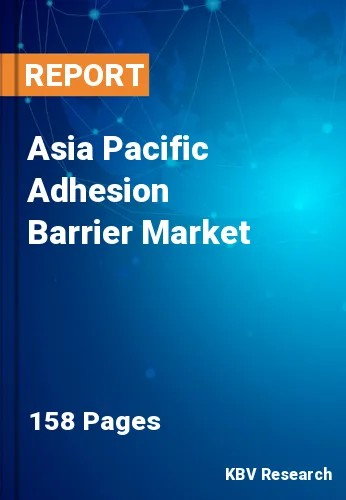The Asia Pacific Adhesion Barrier Market would witness market growth of 7.9% CAGR during the forecast period (2023-2030).
According to surgeons, using the precise surgical technique to prevent adhesion formation during surgery and treatment is crucial. Several medications and other substances, such as animal membranes, gold foil, sheets made of rubber, teflon, and mineral oil, have been used as adjuvants to reduce the risk of adhesion formation for the past century. Unavoidable adhesions develop following abdominal and pelvic surgery. Adhesion causes considerable post-surgical morbidity, infertility, bowel obstruction, and pelvic or abdominal pain. Surgeons may use adhesion barriers during abdominal and pelvic surgery to eliminate obstructions.
Gel-form adhesion barriers are frequently preferred because they are sterilized, transparent, and viscous, allowing them to form a barrier to prevent or decrease adhesions at the surgical site. Glucose polymers with a high molecular weight, including Icodextrin, are also utilized to prevent internal tissues and organs from adhering to one another during and after surgery. Both adhesion barriers can reduce the risk of post-surgical adhesions, and various commercially available products exist.
According to the National Library of Medicine, with numerous studies showing significant heterogeneity, the overall incidence of osteoarthritis (OA) in South Asia was 16.05. In South Asia, the pooled prevalence of osteoarthritis was 16.4%, and in East Asia and the Pacific, it was 15.7%. In India, there were 62.35 million people with OA in 2019. From 4,895 in 1990 to 5313 in 2019 per 100,000 people, the age-standardized prevalence of OA rose significantly in the nation. Similarly, from 1990 to 2019, age-standardized DALYs (disability-adjusted life years) went from 164 to 180 per 100,000 people owing to OA, growing from 0.79 million to 2.12 million. Due to this, with the rising cases of OA, the growth prospects for the market in APAC region increases.
The China market dominated the Asia Pacific Adhesion Barrier Market by Country in 2022 and would continue to be a dominant market till 2030; thereby, achieving a market value of $91.2 million by 2030. The Japan market is registering a CAGR of 7.2% during (2023 - 2030). Additionally, The India market would showcase a CAGR of 8.5% during (2023 - 2030).
Based on Application Area, the market is segmented into General/Abdominal Surgeries, Orthopedic Surgeries, Gynecological Surgeries, Cardiovascular Surgeries, Urological Surgeries, Neurological Surgeries, Reconstructive Surgeries, and Others. Based on Formulation, the market is segmented into Film Formulations, Gel Formulations, and Liquid Formulations. Based on Product, the market is segmented into Synthetic Products (Hyaluronic Acid, Regenerated Cellulose, Polyethylene Glycol, and Others), and Natural Products. Based on End User, the market is segmented into Hospitals & Clinics, Ambulatory Surgical Centers, and Others. Based on countries, the market is segmented into China, Japan, India, South Korea, Singapore, Malaysia, and Rest of Asia Pacific.
Free Valuable Insights: The Worldwide Adhesion Barrier Market is Projected to reach USD 1.2 Billion by 2030, at a CAGR of 7.2%
The market research report covers the analysis of key stakeholders of the market. Key companies profiled in the report include Sanofi S.A., Becton Dickinson and Company, Baxter International, Inc.(Hill-Rom Holdings, Inc.), Johnson & Johnson, Anika Therapeutic, Inc., FzioMed, Inc., MAST Biosurgery USA, Inc.(MAST Biosurgery AG), Innocoll Biotherapeutics N.A. Inc., Luna Innovations, Incorporated and Integra LifeSciences Holdings Corporation.
By Application Area
By Formulation
By Product
By End User
By Country
Our team of dedicated experts can provide you with attractive expansion opportunities for your business.

